I have noted on several occasions in The New Leaf Journal that my favorite movie is Makoto Shinkai’s 2007 three-act piece on feelings and distance, 5 Centimeters Per Second. In this post, I will cover in detail one of the finest scenes of the first act of 5 Centimeters Per Second – wherein Takaki Tōno wistfully remembered the times he shared with his best friend, Akari Shinohara, before she moved away. With Tenmon’s beautiful Distant Everyday Memories playing in the background, Mr. Shinkai managed to meaningfully depict the close friendship between Takaki and Akari in 100 second trip through Takaki’s memories – making remarkably economical use of time.
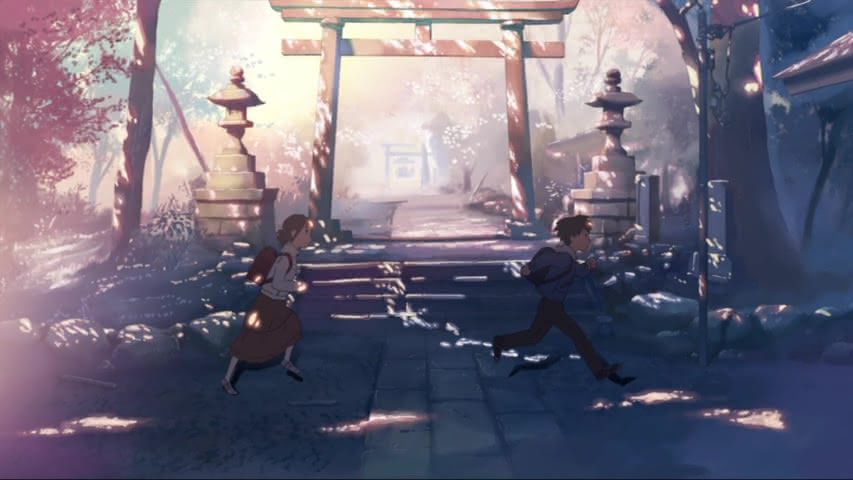
(Note: I took all of the screen captures used in this article from my DVD copy of 5 Centimeters Per Second.)
A Short Overview of 5 Centimeters Per Second
Before I begin my analysis, a short introduction is in order.
5 Centimeters Per Second is a Japanese animated film that was first released in theaters in Japan on March 3, 2007. In was the second full-length movie created and directed by Mr. Makoto Shinkai, who subsequently became the second director to produce an anime film that grossed more than $100 million in the Japanese box office (Your Name in 2016).
5 Centimeters Per Second is a collection of three short movies (or acts): Cherry Blossom, Cosmonaut, and 5 Centimeters Per Second. The main character throughout the story is Takaki Tono – although he is only the view-point character in the first and third acts. Cherry Blossom – which is the act that we will examine here – takes place in Tokyo in 1995 with Takaki in junior high school. The second act, Cosmonaut, takes place in 1999 when Takaki is in high school. The final act, 5 Centimeters Per Second, takes place in 2008 when Takaki is an adult.
Mr. Shinkai has a distinct interest in how feelings, and in particular love, travel over great time and distance. His first two notable films – the short Voices of a Distant Star and the full-length The Place Promised in Our Early Days, looked at the theme through the lens of science fiction. 5 Centimeters Per Second is in all respects a distinctly more down-to-Earth piece, set in the world that we inhabit.
Cherry Blossoms, the first act of 5 Centimeters Per Second Specifically
Because my article is an examination of a single scene from the first act of 5 Centimeters Per Second – Cherry Blossoms – I will limit the scope of my plot-specific overview to this act.
Takaki Tono is a junior high school student in Tokyo in 1995. The very first scene of the movie features Takaki and Akari when they both lived in Tokyo. While playing under the cherry blossom trees, Akari informs Takaki that cherry blossoms fall at a rate of 5 centimeters per second. After impressing him with that fact, Akari tells Takaki that they should see the cherry blossoms together again the next year.
Subsequent events would complicate the fulfillment of Akari’s wish. Takaki remains in Tokyo while Akari moves with her parents north to Tochigi. After the brief opening scene from their time together, there are several scenes in which we hear Akari’s voice reading letters that she sent to Takaki interspersed with scenes from their respective lives in Tochigi and Tokyo, respectively.
They receive a jolt when Takaki learns that he would soon be moving to Kagoshima, which rests in the southernmost part of Japan. Recognizing that this would be their last chance to see each other for some time, Takaki decides to make the trip to Tochigi on a winter evening to visit Akari. Akari promises to wait for him at her small local train station. The promised date is March 4, 1995.
The scene that I will examine takes place as Takaki begins his journey from Tokyo to Kagoshima, so I will not summarize the first act much beyond that. However, the act revolves around Takaki’s struggles to reach Tochigi as his train is delayed repeatedly by inclement weather and other issues. While he does eventually reach Kagoshima and meet Akari, the trip highlights the weight of the physical and temporal distance between them – a theme that Mr. Shinkai hammers home repeatedly and aesthetically throughout the first act of the three-part 5 Centimeters Per Second.
Scene: Takaki’s Distant Everyday Memories
The scene that I am covering begins at about 6:45 into 5 Centimeters Per Second and runs until about 8:25. I titled this section Distant Everyday Memories for two reasons. Firstly, it fits the content of the scene well. Secondly, it is the name of the beautiful background music playing during the scene.
Reminiscing on the Train
Mr. Shinkai gave himself a difficult challenge in this scene. The strength of Takaki’s sentiments about Akari is a central point in all three acts of 5 Centimeters Per Second. Yet 5 Centimeters Per Second is not only a relatively short movie (just over one hour), but its three acts takie place in different times and places. The first act takes place entirely after Takaki and Akari have already been separated. Mr. Shinkai thus left himself with precious little time to depict their earlier years together and why those times were dear to Takaki. In my view, he does a remarkably good job not only condensing the strength of their relationship into just under two minutes while also advancing the main theme of the movie as a whole.
As the train begins a journey that should take one hour, Takaki looks wistfully out of the train window and reminisces about the few years he spent with Akari Shinohara when both lived in Tokyo.

The first part of Takaki’s flashback finds him and Akari under the cherry blossoms in what was most likely mid-to-late April or early May in Tokyo (note a school year in Japan starts in April).

Akari notices a cat – Chobi – that they were both familiar with. Takaki notes that Chobi was always at a shrine in that area. Akari notices something else. Chobi was usually with a cat named Mimi. Yet on this day, they found Chobi alone. Akari speculates that Chobi must be lonely.
After visiting Chobi, Akari and Takaki race a to buy food at a fast food restaurant, Takaki asks Akari about a book she was reading. Akari says that the book was good, and that she had “read about four billion years’ worth last night.” Akari and Takaki were on the same wavelength as they discuss their favorite epochs and prehistoric creatures over their burgers and fries.

Takaki’s flashback goes back further. He had moved to Tokyo on account of his father’s work in 1990. Akari joined one year later in 1991. Takaki recalls that they became fast friends. He explains that they “were both small and prone to illness.” By nature, they preferred the library to playing outdoors.
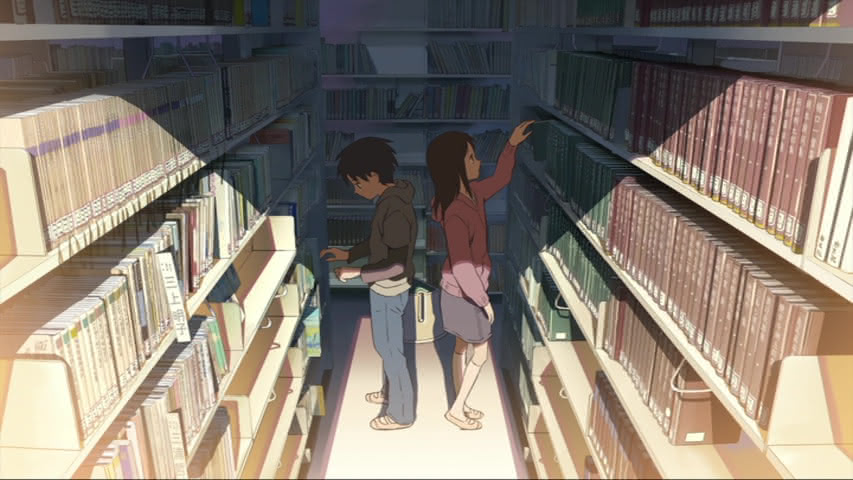
Through their shared temperaments and interests, Takaki and Akari grew close and developed and special bond. Takaki describe him and Akari as kindred spirits.
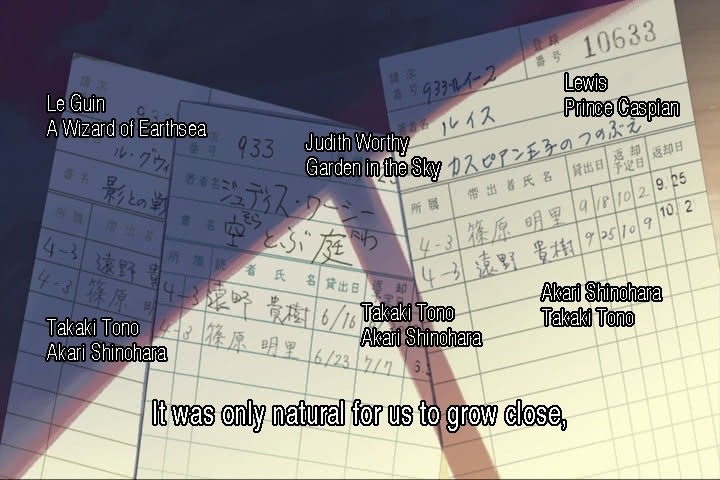
Takaki and Akari were teased often by their classmates due to the fact that they spent so much time together. Takaki explains, however, that it did not bother them precisely because they had each other.
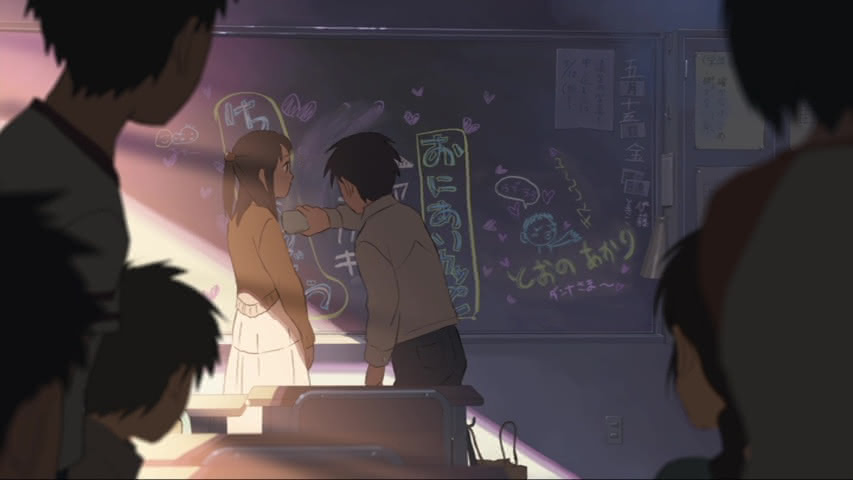
In the final scene of the flashback, Takaki erases the blackboard on which his classmates had written jokes about him and Akari. He takes her by the hand and runs with her from the classroom down a shockingly beautiful school hallway that looks as if it stretches into infinity.
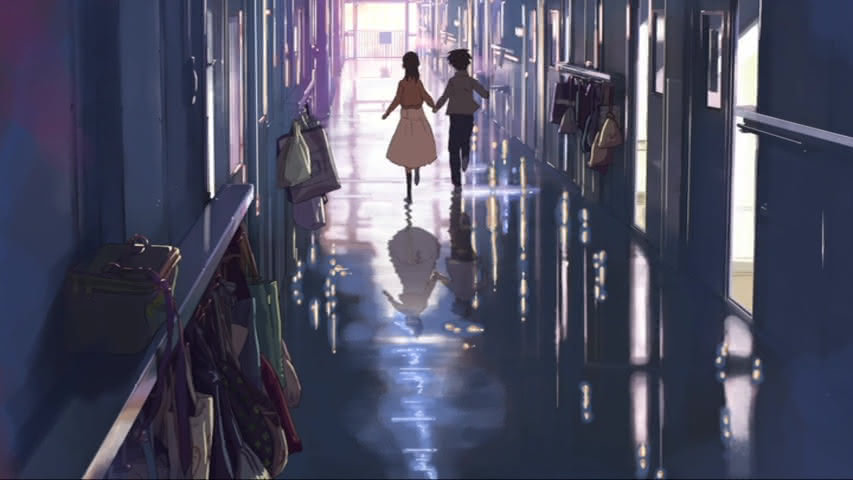
Takaki wistfully recalls that he assumed that he and Takaki would end up going to junior high school together. Beyond that, he assumed that they would “always be together.”
For some reason, I honestly believed that.
Takaki Tōno (original Crunchyroll translation)
Takaki’s flashback in the movie ends with those words. The scene returns to the present with Takaki navigating his way through a train station transfer en route to meeting Takaki in Tochigi.
Distant Everyday Analysis
Takaki’s flashback is a remarkable scene because it shows the depth of his and Akari’s feelings for each other in just a few snippets from the brief time they spent together in Tokyo. In so doing, Mr. Shinkai highlights the themes of time and distance that pervade the entire movie.
Takaki’s and Akari’s memories were created at a time when their worlds were small and quaint – as should be the case for children. Although they lived in the world’s largest city, they spent time together in a small number of places: school, the library, the local shrine, etc. Neither Takaki nor Akari had a clear and distinct idea of how big the world was. Their entire world was the small world that they shared together. In contrast, Takaki and Akari in the present were already grappling with how large the world was. First Akari had to move, which resulted in the two friends who had spent all their free time together becoming pen pals. But Akari did not move so far as to render the idea of their meeting again implausible. It was only when Takaki learned that he was moving south did they realize that seeing each other would be nearly impossible for them as children. This, combined with their both having grown in the year they had already spent apart, made both Takaki and Akari understand how large the world was.
Much like Thornton Wilder did in Our Town, one of my favorite works of literature, Mr. Shinkai has his young friends think in terms of “always” without fully understanding what that entails. In the first scene, Takaki notes that Chobi the cat is “always” at the shrine. Akari however noted that Chobi’s “friend” Mimi, who was “always” there as well, was notably absent. In her musing that Chobi must be lonely, it occurred to neither her nor Takaki that the same fate would fall upon them in the near future.
In the scene where Takaki and Akari discuss a book about prehistoric creatures and eras, they discuss consuming billions of years of history in a single day. This scene serves two purposes. It highlights how close Takaki and Akari were in that they shared interests (reading and prehistoric animals) and knew each other well enough to finish each other’s sentences. The second purpose, however, is to show how they discussed vast amounts of time. To the young friends, time was more of an idea than a weighty fact. Once they were separated, both Takaki and Akari gradually came to realize that they were changing in their new places and environments.
The scene where Takaki described how he and Akari became fast friends is interesting as it approaches the central themes of 5 Centimeters Per Second from a different angle. Takaki noted that he and Akari bonded over having several things in common. They had both moved to Tokyo because of their parents’ work. Both Takaki and Akari were small and sickly. They had in common that they both preferred the library and reading to playing outdoors. To the young Takaki, it felt as if they were kindred spirits. Astute observers of the early part of the movie will note a contrast between Takaki’s present and his memories. In the earlier scenes of the movie showing Takaki’s and Akari’s life while they read their letters to each other – Takaki was shown to be a member of his junior high school’s soccer team while Akari was shown to be reading on a bench. To be sure, the movie does not go into great detail about their personalities and interests, but the difference between younger Takaki vs present Takaki was deliberate. When Takaki grew close to Akari, he spent all his time with her in the library and walking around. In the time they spent apart, Takaki grew and took an interest in sports – going so far as to join the soccer team. This highlights how in the time they spent apart from each other, they grew, changed, and developed new interests and hobbies.
The final scene is a scene of defiance that also fits in with the grander themes of 5 Centimeters Per Second. Takaki and Akari were very obviously close to their classmates. For example – one nuance that is left out of dubbed versions of the movie (as opposed to Japanese subtitles) is that of honorifics. Takaki and Akari referred to each other by their first names with no honorifics – which signified how close they were. It is of little surprise that their elementary school peers decided to tease them over their close relationship.
In the teasing scene, we find an upset Akari standing alone, staring at the blackboard confronting h er classmates’ jokes about her and Takaki . As Takaki remembers the scene, he states that his classmates’ jabs meant nothing to him and Akari because they “had each other.” Takaki confidently walked into the classroom, erased the board, took Akari by the hand, and ran out of the room together.
When Takaki and Akari were together in their small world in Tokyo, they could defy those who wanted to tear them apart or diminish their friendship. It was true that, because they had each other, they could ignore their classmates – none of whom meant to them what they meant to each other. The scene of Takaki’s and Akari’s escape is beautifully animated (however – I doubt any school hallway is as beautiful as the one Mr. Shinkai depicts). They run off toward a light in what almost appears to be an endless hallway – into an apparent eternity, so to speak. It is with this memory that Takaki reminisces that he thought he and Takaki would be together forever. During those increasingly distant days, nothing could separate them. However, Takaki and Akari could do nothing about being forced to move due to their parents’ work. That, unlike the taunts of their classmates, was not anything that children had the power to erase or run away from. Thinking back, Takaki wistfully expressed his disbelief that he had “honestly” believed that he and Akari would be together forever. With a bit of growing up and distance, he realized the world was larger, and sometimes crueler, than he understood in those halcyon days under the cherry blossoms.
Final Thoughts
Mr. Shinkai accomplishes in less than two minutes what many full-length series fail to do . He not only summarizes a beautiful childhood friendship, but also does so in the context of the ideas of time and physical distance that characterize 5 Centimeters Per Second, as well as a number of his other movies. The sentimental and cerebral nature of the sequence, in conjunction with the genius use of lighting and beautiful soundtrack, make Takaki’s distant everyday memories scene one of the finest anime scenes ever produced. It is only because of the sublime aesthetic sensibilities that go into a number of other scenes in 5 Centimeters Per Second that Takaki’s distant everyday memories is not the clear and indisputable finest scene in the movie – but a discussion of the other contenders will have to be reserved for future articles.
Watching 5 Centimeters Per Second
It goes without saying that I think you should watch 5 Centimeters Per Second yourself. It used to be hosted on Crunchyroll, but there appear to be significant region locks on it now. It is readily available to stream online, but you can purchase an official DVD/Blu-Ray copy on Amazon or various other sites that sell physical movie media. I personally recommend watching it with Japanese dialogue and English subtitles in the first instance. While I prefer this configuration for anime generally, there are certain nuances that I found were missing in the first two acts in the fully dubbed version of the movie that I saw.